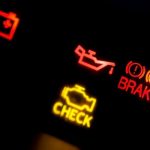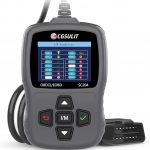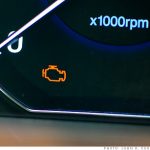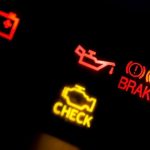That sinking feeling when the check engine light illuminates on your dashboard is something most drivers know all too well. It’s a warning sign that something might be amiss with your vehicle, but deciphering its meaning can be a challenge. A check engine light detector, also known as an OBD2 scanner, empowers you to understand these warnings and take control of your car’s health. This comprehensive guide delves deep into the world of check engine light detectors, exploring their purpose, various types, essential features, and how to use them effectively.
What is a Check Engine Light?
The check engine light, formally known as the malfunction indicator lamp (MIL), is your vehicle’s way of communicating potential issues. It’s a signal from the car’s engine computer, alerting you to a possible malfunction within the engine or emission system. While often associated with engine problems, this warning light can be triggered by a range of issues, from a simple loose gas cap to more serious concerns like a faulty catalytic converter or internal engine problems.
This warning light typically appears as an outline of an engine, and its color can vary depending on the vehicle and the severity of the issue. While commonly amber or red, some vehicles use green or blue lights to indicate that certain features are active and operating correctly. In some car models, the check engine light may even illuminate based on the odometer reading as a reminder for specific maintenance tasks.
Understanding the different types of check engine light warnings is crucial:
- Solid Light: A steady check engine light usually suggests a non-urgent issue, such as a minor sensor malfunction or an emissions-related problem. It’s essential to address this promptly, but it doesn’t necessarily pose an immediate threat to your vehicle.
- Flashing Light: A flashing check engine light signals a severe problem that requires immediate attention. This could indicate a critical issue like an engine misfire, which, if left unaddressed, could damage expensive components like the catalytic converter or even lead to engine failure.
It’s important to note that the check engine light itself doesn’t tell you exactly what’s wrong. It simply indicates that the car’s onboard diagnostic system has detected a malfunction. To pinpoint the issue, you’ll need a check engine light detector to read the specific diagnostic trouble codes (DTCs) stored in the vehicle’s computer.
What is a Check Engine Light Detector?
A check engine light detector, also known as an OBD2 scanner, is a device that allows you to delve into your car’s internal systems and understand the reasons behind that illuminated check engine light. By connecting to your vehicle’s OBD-II port, typically located under the dashboard, these devices act as a bridge between you and your car’s computer, translating complex diagnostic trouble codes (DTCs) into understandable information.
The beauty of the OBD-II system lies in its standardization. Introduced in 1996, it provides a universal method for accessing diagnostic information across different vehicle makes and models. This standardization has been instrumental in making car maintenance more accessible to the average car owner.
Check engine light detectors come in various forms, catering to different needs and budgets:
- Basic Code Readers: These are the most affordable and straightforward type of detectors. They primarily focus on reading and clearing engine-related codes.
- Scan Tools: These offer more advanced functionalities, including access to a wider range of vehicle systems, live data monitoring, and more detailed diagnostic information.
Some detectors connect directly to your vehicle using a cable, while others utilize Bluetooth or Wi-Fi to communicate wirelessly with your smartphone or computer. This wireless connectivity often enhances user experience through dedicated apps with intuitive interfaces and additional features.
Types of Check Engine Light Detectors
With a variety of check engine light detectors available, choosing the right one for your needs is essential. Here’s a closer look at the different types:
- Basic Code Readers: These entry-level devices are perfect for DIYers who want a quick and easy way to understand why their check engine light is on. They can read and clear basic engine codes, providing a starting point for troubleshooting.
- Bluetooth/Wi-Fi OBD2 Scanners: These scanners offer a more modern approach, connecting wirelessly to your smartphone or computer. They often come with dedicated apps that provide a user-friendly interface, live data monitoring, and even performance testing capabilities. The convenience of Bluetooth scanners, coupled with their user-friendly apps and continuous updates, makes them a popular choice for many car owners.
- OBD2 Gauges and Monitors: For car enthusiasts who want to keep a close eye on their engine’s performance, OBD2 gauges and monitors are an excellent option. These devices display real-time data from various sensors in the form of gauges, allowing you to monitor parameters like temperature, pressure, and fuel consumption.
- Multi-System OBD Scan Tools: These scanners go beyond basic engine codes and can diagnose issues in multiple vehicle systems, including ABS, SRS, body, and transmission. They offer a more comprehensive diagnostic approach, making them suitable for those who want to delve deeper into their car’s health.
- Single-Make OBD Scan Tools: If you own a specific car brand and want the most in-depth diagnostic capabilities, single-make scan tools are worth considering. These specialized scanners are designed for particular car brands, offering access to manufacturer-specific codes and advanced functionalities tailored to those vehicles.
- Professional OBD Scan Tools: These are the top-tier scanners used by professional mechanics. They offer the most comprehensive diagnostic capabilities, including bidirectional control, programming functions, and access to a wide range of vehicle systems. While they come with a higher price tag, they provide the most detailed and advanced diagnostic information.
It’s important to distinguish between code readers and scan tools. While both interact with the vehicle’s OBD port, code readers are more basic, primarily focusing on reading and clearing DTCs. Scan tools, on the other hand, offer more advanced functionalities, including the ability to read pending codes, generic codes, and even manufacturer-specific codes.
Features of Check Engine Light Detectors
Check engine light detectors come with a range of features, and understanding these features can help you choose the right device for your needs. Here are some key features to consider:
- Code Reading and Clearing: This is the fundamental function of any check engine light detector. It allows you to read the diagnostic trouble codes (DTCs) stored in your vehicle’s computer and clear them after addressing the issue.
- Live Data Monitoring: Many scanners offer live data monitoring, which allows you to see real-time data from various sensors in your vehicle. This can include engine speed, coolant temperature, oxygen sensor readings, and more. Live data monitoring is invaluable for understanding your engine’s performance and identifying potential problems before they escalate.
- Freeze Frame Data: This feature captures a snapshot of the engine’s operating conditions at the time a fault code was triggered. This information can be crucial in diagnosing intermittent problems that might not be present during a regular scan. Freeze frame data provides a valuable context for understanding the circumstances surrounding the fault code.
- Emissions Testing: Some scanners have the capability to perform emissions tests, which can be helpful if you live in an area with mandatory emissions testing. This feature allows you to check if your vehicle meets the required emission standards before taking it for an official test.
- Manufacturer-Specific Codes: While generic codes provide a general understanding of the problem, manufacturer-specific codes offer more detailed information related to specific vehicle makes and models. Advanced scanners can access these codes, providing a deeper level of diagnostic insight.
- Enhanced vs. Generic Codes: Understanding the difference between enhanced and generic codes is crucial. Generic codes are standardized across all vehicles, while enhanced codes are manufacturer-specific. Advanced scanners can access both types of codes, providing a more comprehensive understanding of the issue.
- Bi-directional Control: This feature, typically found in professional-grade scanners, allows you to send commands to various vehicle systems. This can be used for advanced diagnostics, such as activating solenoids or turning on lights, to test specific components.
Compatibility of Check Engine Light Detectors
Most check engine light detectors are designed to be compatible with a wide range of vehicles. However, understanding the nuances of compatibility is essential to ensure you choose the right device for your car.
OBD-II Standardization: The standardized OBD-II system, mandatory for vehicles manufactured after 1996 in the United States, 2001 for gasoline cars in Europe, and 2004 for diesel cars in Europe, has greatly simplified compatibility. Most scanners are designed to work with OBD-II compliant vehicles, ensuring they can access the necessary diagnostic information.
OBD-II Protocols: While OBD-II is standardized, it encompasses different communication protocols, including SAE J1850 PWM (used in Ford vehicles), SAE J1850 VPW (used in General Motors vehicles), ISO9141-2 (used in Chrysler and various European/Asian vehicles), ISO14230-4 KWP (used in various European and Asian imports), and ISO 15765 CAN (used in all vehicles manufactured after 2008). Ensuring your scanner supports the specific protocols used in your vehicle is crucial for proper communication and accurate readings.
Manufacturer-Specific Codes: Some scanners are better equipped to handle manufacturer-specific codes, which can be essential for diagnosing certain issues. If you require access to these codes, it’s crucial to choose a scanner that explicitly supports them.
Vehicle-Specific Compatibility: While most scanners aim for broad compatibility, there might be limitations with certain vehicle makes, models, or years. It’s always recommended to check the scanner’s documentation or consult the manufacturer to confirm compatibility with your specific vehicle.
Ease of Use
The ease of use of a check engine light detector can significantly impact your diagnostic experience. Fortunately, many modern scanners are designed with user-friendliness in mind.
Basic Code Readers: These typically have simple interfaces with minimal buttons, making them easy to navigate even for beginners.
Bluetooth and Wi-Fi Scanners: These often come with dedicated apps that provide a more intuitive and user-friendly experience. The apps often feature clear displays, helpful guides, and easy-to-understand explanations of the diagnostic codes.
Helpful Features: Some scanners offer features like video-based user manuals and guided tests, which can be particularly helpful for those new to car diagnostics. These features provide step-by-step instructions and visual aids, making the process less intimidating.
User Interface: The quality of the user interface, whether on the device itself or through a companion app, plays a significant role in ease of use. Look for scanners with clear displays, intuitive menus, and easy-to-understand information.
Pros and Cons of Using a Check Engine Light Detector
Investing in a check engine light detector can be a smart move for any car owner. Here’s a breakdown of the pros and cons to help you make an informed decision:
|
Pros |
Cons |
|---|---|
|
Early Detection of Issues: Identify problems early on, preventing minor issues from becoming major repairs and saving you money in the long run. |
Cost: While basic code readers are affordable, more advanced scanners can be expensive. |
|
Improved Vehicle Performance: Addressing engine problems can lead to better fuel efficiency, reduced emissions, and enhanced overall performance. |
Complexity: Some scanners, especially those with advanced features, can be complex to use, requiring some technical knowledge. |
|
Enhanced Safety: Diagnose and fix safety-related issues promptly, ensuring a safer driving experience for you and your passengers. |
Misinterpretation of Codes: While scanners provide valuable information, it’s essential to interpret the codes correctly to avoid misdiagnosing the problem. |
|
Cost Savings: Avoid unnecessary trips to the mechanic for diagnostics, potentially saving on diagnostic fees and labor costs. |
|
|
DIY Fixes: Increase the likelihood of fixing the problem yourself by pinpointing the source of the malfunction. |
|
|
Portability: Many code scanners are portable, making them convenient for those who travel frequently or want to diagnose their car on the go. |
|
|
Peace of Mind: Understand the cause of your check engine light, alleviating stress and uncertainty. |
|
|
Determine Severity: Assess the severity of the problem, allowing you to prioritize repairs and make informed decisions about whether it’s safe to continue driving. |
|
|
Empowerment: Even basic code readers empower car owners with information, allowing them to have more informed conversations with mechanics and potentially avoid unnecessary repairs. |
Cost of Check Engine Light Detectors
The cost of check engine light detectors can vary significantly, depending on the type of device, its features, and the brand.
|
Scanner Type |
Price Range |
Example Models |
|---|---|---|
|
Basic Code Reader |
$20 – $50 |
Ancel AD310, Motopower MP69033 |
|
Bluetooth Scanner |
$40 – $120 |
BlueDriver Bluetooth Pro, FIXD |
|
Mid-Range Scanner |
$50 – $200 |
|
|
Professional Scanner |
$100 – $1,000+ |
Innova 5610 |
Factors Affecting Cost:
- Features: Scanners with more advanced features, such as live data monitoring, emissions testing, and manufacturer-specific code reading, typically come with a higher price tag.
- Connectivity: Bluetooth and Wi-Fi scanners often cost more than basic code readers due to the added wireless connectivity and companion app features.
- Brand: Well-known brands with a reputation for quality and reliability may have higher prices compared to lesser-known brands.
How to Use a Check Engine Light Detector
Using a check engine light detector is generally a simple process, but it’s essential to follow the correct steps to ensure accurate readings and avoid potential issues.
- Locate the OBD-II Port: The OBD-II port is typically located under the dashboard on the driver’s side, near the steering wheel. It’s a 16-pin connector that’s usually easy to access. If you’re having trouble finding it, consult your vehicle’s owner’s manual.
- Connect the Scanner: Plug the scanner into the OBD-II port. The connector is designed to fit only one way, so you can’t connect it incorrectly. Ensure the connection is secure.
- Turn on the Ignition: Turn the ignition key to the “on” position, but don’t start the engine. This will power up the vehicle’s computer and allow the scanner to communicate with it.
- Read the Codes: Follow the instructions on the scanner’s screen or in its manual to read the diagnostic trouble codes (DTCs). The scanner will retrieve the codes from the vehicle’s computer and display them on its screen.
- Interpret the Codes: Once you have the codes, you’ll need to interpret their meaning. You can use the scanner’s manual, an online database, or even consult a mechanic to understand what the codes indicate.
- Address the Issue: After identifying the problem, take the necessary steps to fix it. This may involve simple DIY repairs, such as tightening a loose gas cap or replacing a faulty sensor, or it may require more complex repairs that are best left to a professional mechanic.
- Clear the Codes: After addressing the issue, use the scanner to clear the codes and reset the check engine light. This will turn off the warning light and allow the vehicle’s computer to monitor for any recurring issues.
Troubleshooting Common Problems with Check Engine Light Detectors
While check engine light detectors are generally reliable, you might encounter some issues while using them. Here are some common problems and troubleshooting tips:
- No Power to the OBD-II Port: If the scanner doesn’t power on, check the fuse for the OBD-II port. A blown fuse could prevent the scanner from receiving power.
- No Codes Recorded: If the scanner doesn’t record any codes, there might be a problem with the vehicle’s computer system or the scanner itself. Ensure the scanner is compatible with your vehicle and that the connection to the OBD-II port is secure.
- Inaccurate Readings: Inaccurate readings can be caused by a loose connection, a faulty scanner, or even a problem with the vehicle’s sensors. Double-check the connection and try using the scanner on another vehicle to rule out a scanner malfunction.
- Difficulty Interpreting Codes: If you’re unsure about the meaning of the codes, consult a mechanic or use online resources for more information. Websites like OBD-Codes.com provide comprehensive databases of trouble codes and their potential causes.
- False Flags: It’s important to be aware of potential false flags from check engine codes. Sometimes, a code might be triggered by a temporary issue or a sensor malfunction that doesn’t necessarily indicate a serious problem. Proper diagnosis is crucial to avoid unnecessary repairs.
- Real-World Examples: Some common check engine light issues include faulty oxygen sensors, loose gas caps, catalytic converter failures, spark plug or ignition coil problems, and mass airflow sensor malfunctions. Understanding these common issues can help you troubleshoot problems more effectively.
Importance of Professional Help: While DIY diagnostics can be helpful, it’s important to recognize the limitations of check engine light detectors and seek professional help when needed. For complex issues or if you’re unsure about the diagnosis, consulting a qualified mechanic is always recommended.
Immediate Action: If the check engine light is flashing, it’s crucial to take immediate action. This indicates a serious problem that could cause damage to your vehicle or even pose a safety hazard. Reduce speed, minimize load on the engine, and seek professional assistance as soon as possible.
Different Scenarios:
- Steady Light: If the check engine light stays on and is steady, it usually indicates a less urgent issue. However, it shouldn’t be ignored. Plan to have the vehicle checked by a professional soon.
- Flashing Light: A flashing light signals a severe problem that needs immediate attention. Minimize driving and get the car checked as soon as possible.
- After Addressing the Issue: Once you’ve fixed the problem, the check engine light should automatically turn off after a few driving cycles. If it doesn’t, a visit to a professional might be necessary to reset the car’s computer system.
Legality of Using a Check Engine Light Detector
In most jurisdictions, using a check engine light detector for personal diagnostic purposes is perfectly legal. These devices access information provided by the vehicle’s systems, which is generally not considered private information.
However, it’s crucial to use the device responsibly and avoid tampering with vehicle data illegally. This includes activities like manipulating the odometer or altering emission-related data.
Environmental Impact of Using a Check Engine Light Detector
Using a check engine light detector can have a positive impact on the environment. By identifying and addressing engine problems promptly, you can contribute to cleaner air and a healthier planet.
Reduced Emissions: A malfunctioning engine can release harmful pollutants, such as carbon monoxide, hydrocarbons, and nitrogen oxides, which contribute to air pollution and climate change. By using a scanner to diagnose and fix these issues, you can reduce your vehicle’s emissions and minimize its environmental footprint.
Improved Fuel Efficiency: Engine problems can also lead to reduced fuel efficiency, meaning your car consumes more fuel to cover the same distance. By addressing these issues, you not only save money on fuel but also reduce your carbon footprint.
Examples of Environmental Impact: Ignoring the check engine light can have various environmental consequences. For example, a faulty exhaust gas recirculation (EGR) valve can lead to increased emissions of harmful nitrogen oxides. Similarly, a malfunctioning vacuum hose can affect engine performance and increase fuel consumption.
OBD2 Scanners and the Environment: OBD2 scanners play a crucial role in identifying and remedying emission-related issues in vehicles. By ensuring your car’s emission control systems are functioning correctly, you contribute to cleaner air and a healthier environment.
The Future of Check Engine Light Detectors
The world of check engine light detectors is constantly evolving, with new technologies and features shaping the future of car maintenance.
- Advanced Diagnostics: Scanners are becoming more sophisticated, with the ability to perform more complex diagnostics and provide more detailed information about vehicle problems. This includes accessing a wider range of vehicle systems, analyzing real-time data more effectively, and providing more accurate diagnoses.
- Real-Time Data Analysis: Real-time data analysis is becoming increasingly important in modern scanners. This allows for preemptive diagnostics, quicker identification and correction of engine issues, and more efficient maintenance.
- Predictive Maintenance: Some scanners are now incorporating predictive maintenance capabilities. By analyzing data from various sensors, these scanners can predict potential problems before they occur, allowing for proactive maintenance and preventing costly repairs.
- Integration with Mobile Apps: Many scanners now offer companion apps that provide a user-friendly interface, access to online resources, and additional features like repair estimates and maintenance reminders. These apps enhance the user experience and make it easier to manage your car’s health.
- Maintenance Reminders: Some scanners can even provide maintenance reminders based on your car’s make, model, and mileage. This helps you stay on top of routine maintenance and prevent potential problems.
- Avoiding Rip-offs: Scanners like FIXD Premium can help you avoid rip-offs by providing fair market prices for repairs. This empowers you with information and allows you to make informed decisions about repair costs.
- Artificial Intelligence: AI-powered diagnostic tools are emerging, with the potential to revolutionize car maintenance. These tools can analyze data from various sensors and provide more accurate and efficient diagnostics, potentially reducing repair times and costs.
Conclusion
A check engine light detector is a valuable tool for any car owner, from the casual driver to the dedicated DIY enthusiast. It empowers you to understand your car’s health, diagnose potential problems, and take control of your vehicle’s maintenance.
By choosing the right type of scanner and using it effectively, you can enjoy a range of benefits, including:
- Saving money on repairs: By identifying problems early and potentially performing DIY fixes, you can avoid costly diagnostic fees and labor costs.
- Improving your car’s performance: Addressing engine issues can lead to better fuel efficiency, reduced emissions, and a smoother driving experience.
- Enhancing safety: Diagnosing and fixing safety-related issues promptly ensures a safer driving experience for you and your passengers.
- Contributing to a cleaner environment: By keeping your engine running efficiently, you can reduce emissions and minimize your environmental impact.
- Gaining peace of mind: Understanding the cause of your check engine light can alleviate stress and uncertainty, giving you confidence in your car’s health.
To minimize the chances of your check engine light illuminating in the first place, remember these preventative measures:
- Regular Maintenance: Follow your vehicle’s recommended maintenance schedule, including oil changes, air filter replacements, and spark plug checks.
- Tighten the Gas Cap: Ensure your gas cap is securely tightened after every fill-up.
- Drive Responsibly: Avoid aggressive driving habits that can put extra stress on your engine.
- Use Quality Fuel: Use the recommended fuel type for your vehicle and avoid low-quality fuel that can cause engine problems.
With the information and guidance provided in this comprehensive guide, you’re well-equipped to navigate the world of check engine light detectors and take charge of your car’s health.






